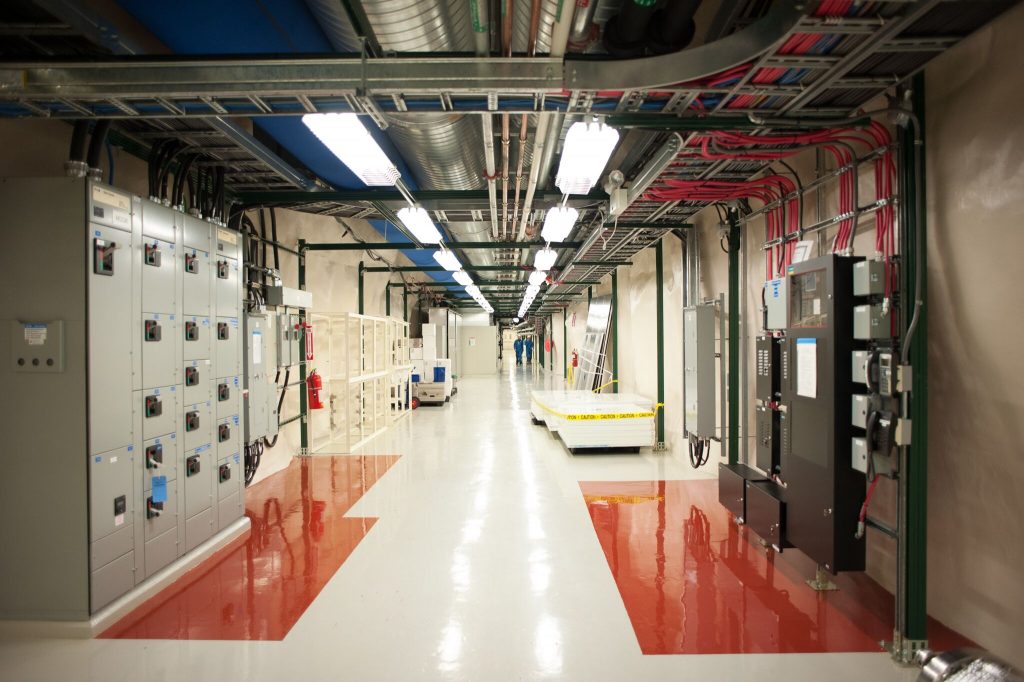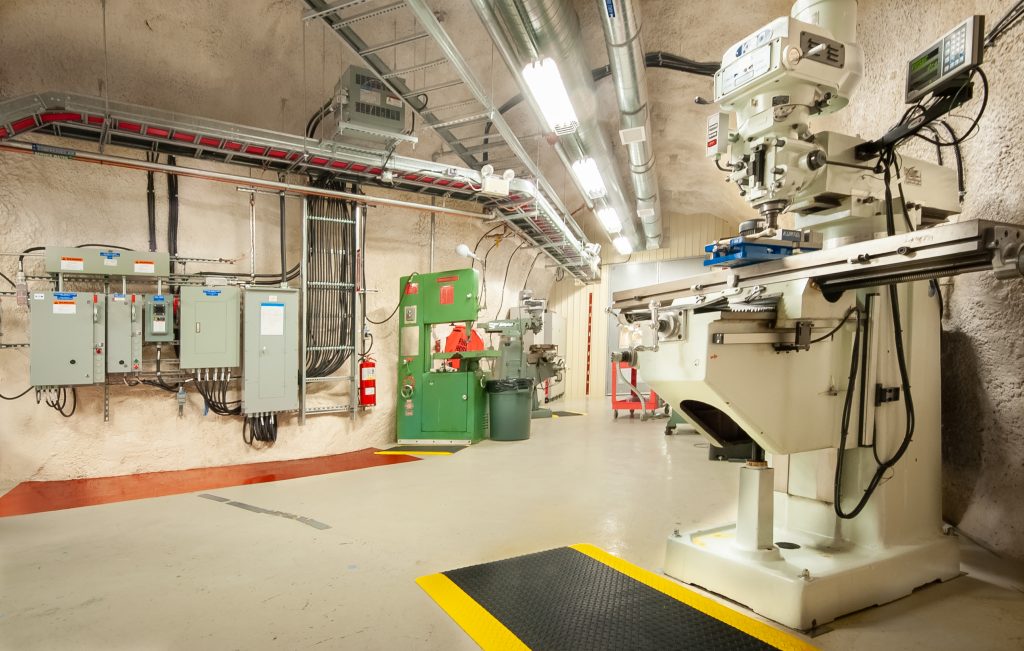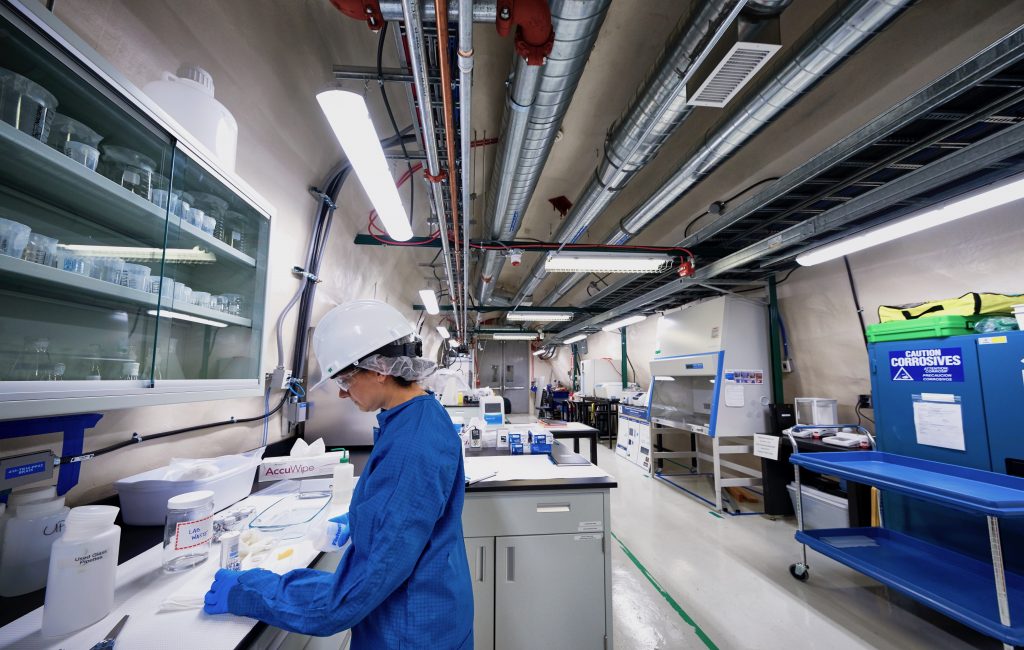
SNOLAB’s underground lab is an expansion of the original SNO facility which consisted of a large cavern housing the detector and additional drift space supporting infrastructure and personnel. The entrance to the underground facility is on the 6800 ft level of Vale’s Creighton mine via 9 Shaft and SNOLAB’s underground facility is 1.8 km from the shaft itself. The ambient rock temperature on the 6800 level is 42C and there is a 2070 m norite rock overburden. SNOLAB was designed and operates as one large clean room, continuing the successful approach used by the SNO experiment. To achieve this, everything and everyone entering the underground lab is cleaned. People remove their mine gear, shower, and don cleanroom clothing that reduces dust. All equipment and materials for experiments or the lab itself are either cleaned in the underground carwash before entering the lab, or cleaned on surface and sealed for shipping.
The SNOLAB underground laboratory has 5,000 m2 of clean space, of which 3,100 m2 is experimental cavern space. SNOLAB has an additional 2,600 m2 excavated outside the clean room used for the service infrastructure and material transportation and storage. The clean underground spaces have painted concrete floors and shotcreted walls which are painted with a radon-blocking paint. Outside the clean space, drift walls are bolted and screened. The material handling area immediately outside the laboratory entrance has concrete pads to facilitate bringing material into the lab, and other areas have bare gravel on the drift floors.
SNOLAB has four main experimental areas underground. The SNO cavern, Cryopit, and Cube Hall are experimental caverns for large experiments, and the Ladder Labs are drift areas for small and medium-sized experiments. The Cryopit is designed for an experiment using a large volume of cryogenic liquid and is isolated from the rest of the laboratory for safety in the event of a cryogen leak. There is a chemistry lab and low background counting lab underground which both support the large experiments and take advantage of the unique research environment for other explorations.
In addition to experimental spaces, the underground facility has control rooms, plants, and storage areas to support experiments, a clean machine shop, laundry facilities, a meeting room, and lunchroom/refuge for personnel. Outside of the cleanroom facility, additional space houses the air handling units (filters and chillers), generator, and waste treatment plant.

Machine Shop:
SNOLAB has a small ’clean’ machine shop located underground. As clean as the space is, a machine shop is inherently dirtier than other parts of the lab and is located in an isolated section of the laboratory. An underground shop was set up so that experiment components and equipment can be worked on without being exposed to surface levels of background radiation. Currently, the shop contains a lathe, milling machine, drill press, cut off saws, and a band saw. SNOLAB’s integration department manages the clean machine shop underground and the larger one on surface. The group is also available to assist in the design of new experiments, construct simple equipment, repair and modify existing laboratory equipment, and modify parts for background testing. To understand more about the type of work possible in the machine shop, please contact integration@snolab.ca.

Chemistry Lab:
SNOLAB’s underground Life Sciences & Chemical Laboratory is shared by the scientific support team and the REPAIR experiment. The space allows QA and compatibility testing for experiments to be done underground. The facility has bench space, a fume hood, an ultra pure water system, an analytical balance, chemical storage, and ultrasonically cleaned equipment. There are a number of analytical instruments including a UVVis spectrophotometer, total organic carbon analyzer, pH meter, conductivity meter, density meter, turbidimeter, calorimeter, and refractive index meter. The REPAIR experiment also operates a radon-free glove box in the space for their cell work. For more information about the type of work possible in the chemistry lab, please contact scientificsupport@snolab.ca.
Low Background Counting:
SNOLAB has a low background counting facility underground capable of providing assays and measurements for the user community. Currently, the facility provides services in gamma counting using ultra-low background germanium detectors, alpha counting using an XIA alpha counter, passive radon emanation, radon and thoron measurements with electrostatic counters and alpha-beta counters, X-ray Fluorescence (XRF) spectrometry, and general gamma spectroscopy. The facility offers consultation to experiments and projects and tests all materials for current and future experiments for radon emanation levels to ensure they do not interfere with the data collected. For more information about the type of testing possible in the low background counting facility, please contact scientificsupport@snolab.ca or visit the low background counting facility website.